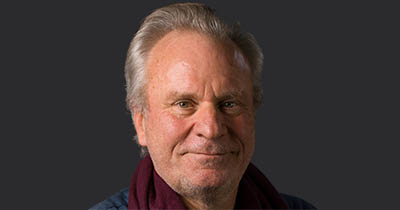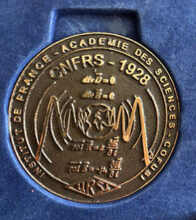Joe Wiart, Radioelectricity French Commitee 2025 medallist
30 June 2025
 The CNFRS/URSI-France Medal, awarded under the aegis of the French Academy of Sciences des Sciences, is intended to honour a scientist who contributes, or has contributed over at least the last six years, to remarkable advances in the field of radio science, and has participated in the scientific leadership of the French and international community. This contribution may concern advances in knowledge and/or the contribution of radio sciences to the socio-economic world and/or dissemination to the radio science community, young scientists or the general public.
The CNFRS/URSI-France Medal, awarded under the aegis of the French Academy of Sciences des Sciences, is intended to honour a scientist who contributes, or has contributed over at least the last six years, to remarkable advances in the field of radio science, and has participated in the scientific leadership of the French and international community. This contribution may concern advances in knowledge and/or the contribution of radio sciences to the socio-economic world and/or dissemination to the radio science community, young scientists or the general public.
Joe Wiart is an « Ingénieur Général des Mines ». He graduated from Télécom Paris (formerly the École Nationale Supérieure des Télécommunications, ENST) in 1992, and obtained a doctorate from ENST and the Pierre-et-Marie-Curie University in 1995, followed by a habilitation to direct research (HDR) from the same university in 2015.
He began his research career in 1992 at France Télécom’s Télécommunications National Study Center (CNET), and continued his work at Orange until 2015. At that time, he joined Télécom Paris to head the C2M chair – Characterisation, Modelling and Control of Exposure to Electromagnetic Waves – set up by the Institut Mines-Télécom, supported by Télécom Paris and backed by the Frequencies French National Agency (ANFR).
His early work in radio science focused on the propagation of radio waves, before he specialised in quantifying exposure to radio frequencies. He then developed deterministic and numerical approaches, notably based on the FDTD method, to assess exposure to organs such as the brain. During the decade, he and Pierre Noël Favennec (CNET) initiated the first French research programme on wave-person interactions, followed by the COMOBIO programme with Bernard Veyret (IMS Bordeaux), as part of the French National Network for Research in Telecommunications (RNRT).
His early work in radio science focused on the propagation of radio waves, before he specialised in quantifying exposure to radio frequencies. He then developed deterministic and numerical approaches, notably based on the FDTD method, to assess exposure to organs such as the brain. During the decade, he and Pierre Noël Favennec (CNET) initiated the first French research programme on wave-person interactions, followed by the COMOBIO programme with Bernard Veyret (IMS Bordeaux) as part of the French national network in telecommunications (RNRT).
From 1998 onwards, he was involved in the European standardisation work carried out by European Committee for Electrotechnical Standardization (CENELEC), contributing to the development of standard measurement methods. Still very much involved in this field, he now chairs the TC106x technical committee, which is responsible for assessing human exposure to electromagnetic fields.
During the 2000s, he contributed to the development of a hybrid methodology combining numerical modelling and experimental measurements, aimed at assessing actual exposure of the brain during the use of mobile phones in operational conditions. He has taken part in several major international epidemiological studies, including Interphone, Mobikids and Geronimo. He leads a number of projects funded by the French National Agency (ANR) and French National Agency for Food, Environmental and Occupational Health and Safety (ANSES), focusing in particular on children’s exposure, the design of innovative anatomical models and the development of hybrid digital methods. This work is carried out in close collaboration with the teams of Isabelle Bloch (Télécom Paris) and Christian Persan (IMT Atlantique), and culminated in 2009 in the creation of the WHIST Lab, a joint laboratory of the Institut Télécom and Orange Labs.
In 2010, to deal with the growing variability of uses and networks, he introduced statistical modelling in dosimetry, complementing deterministic approaches. In 2015, he became director of the C2M Chair. From 2019, in collaboration with Shanshan Wang (senior lecturer at Télécom Paris), he will be initiating the integration of artificial intelligence tools in the field of dosimetry.
Alongside his scientific work, Joe Wiart has held a number of positions of responsibility in the field of radio science. He was Chairman of Commission K of URSI France (2006-2009), Chairman of URSI France (2009-2012), then Chairman of Commission K of URSI International (2014-2019). Between 2018 and 2020, he chaired the steering committee of the Observatoire Ondes-Paris of the City of Paris and, since 2023, has been a member of the Observatoire parisien de la téléphonie mobile.
Since 2017, he has also chaired the European technical committee CENELEC TC106x, which is responsible for drawing up standards relating to exposure to electromagnetic fields.
In conclusion, Joe Wiart has led or contributed to numerous national and international projects dedicated to dosimetry, such as the European Lexnet project, or the ANSES Acte and AMPERE projects. He has received particular recognition for his research work on numerical methods and statistics applied to electromagnetism and stochastic dosimetry, which has resulted in over 130 publications in peer-reviewed journals and more than 200 conference presentations.